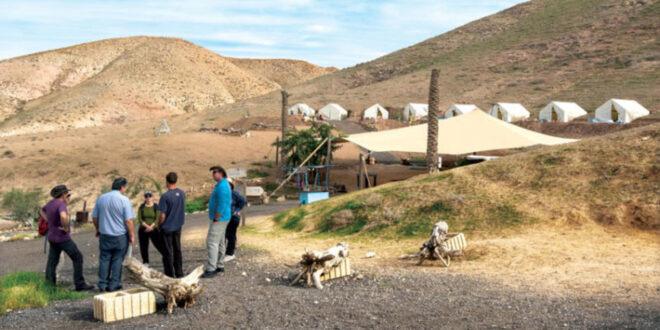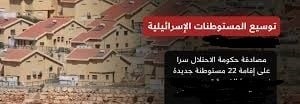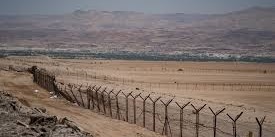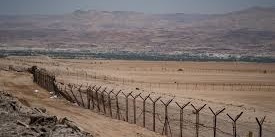By: Madeeha Al-A’raj
The national Bureau for Defending Land and Resisting Settlements stated in its latest weekly report , that ‘Mikor Rishon Newspaper’ allied to the Israeli right-wing, disclosed a plan by the so-called ‘Israel Land Authority’ to establish 3 new settlements, and build about 9,500 new housing units in the Jordan Valley, claiming that the plan aims to strengthen settlement in the eastern border area to avoid the occurrence of Oct. 7 again. The Land Authority conducted a survey to find land suitable for construction, resulted in identifying 3 sites; each of which has an area of 750 – 1,500 donums, located on area ‘C’ west of the St. 90 in the Jordan Valley.
Worth mentioning that the Palestinian Valleys extend along the eastern borders of the West Bank from the Ein Gedi village in the south near the Dead Sea, to the Ein al-Baida area adjacent to the Bisan area in the north, its length is 120 km with a width ranges between 5-20 km depending on its proximity from the mountain series of the West Bank overlooking the Palestinian Valleys, which constitute 28% of the West Bank’s area, with an area estimated at about 1600km2, in which more than 65,000 Palestinians live, and includes 27 fixed permanent population centers on an area of 10,000 donums, and dozens of pastoral and Bedouin communities, administratively affiliated to the Tubas Governorate ‘(Northern Jordan Valley’ in which 11 communities live, Nablus Governorate ‘Central Jordan Valley’ in which 4 communities live, and Jericho Governorate ‘Southern Jordan Valley’ in which 12 communities live.
Since the beginning of 2023, the Jordan Valley, especially the northern and central areas witness settler activities to seize new lands to annex them, which have begun to encircle Palestinian citizens there, and deprive them of their agricultural and pastoral lands. The Jordan Valley’s areas were divided under the Oslo Accords into Area ‘A’ about 85 km2, controlled by the Palestinian National Authority, i.e. about 7.4% of the total area of the Jordan Valley; Area ‘B’ 50 km2, which is a jointly shared area between the Authority and Israel, i.e. about 4.3% of the total area of the Valley; and Area ‘C’, under full Israeli control, about 1,155 km2 i.e. about 88.3% of the Valley.
The Valley occupied 50% of the agricultural land in the West Bank and has for years supplied the Palestinian local market with about 60% of its food needs of vegetables and fruits, so it has been called the ‘food basket of Palestine.’ As for water, the Valley lies on the eastern basin, the second largest groundwater reservoir in the West Bank, with a capacity of 173 million cubic meters and contains 50% of Palestinian water resources. The occupation controls 85% of the valley’s water resources.
As for water consumption, the Israeli settler consumes about 287 liters of water per day, while the Palestinian citizen consumes about 20 liters per day. The Occupation Authorities don’t give Palestinians licenses to dig wells, regardless of their depth, while the Israeli water ‘Mekorot company digs wells, some of which reach a depth of 100 meters to supply the settlers and their farms with water over the year.
The Occupation Authorities began settlement in the Jordan Valley early after the occupation of the West Bank in June 1967, and established the ‘Mehola settlement’ in Feb, 1968, about 9 months after the occupation of the West Bank and the Gaza Strip. Then, settlement activities in the Jordan Valley continued in small settlement blocs, where settlement nuclei were built, distributed over the Nablus, Jericho, and Tubas Governorates, until they became about 27 settlements ‘19’ in Jericho and 8 in Tubas.
In addition, many population centers were subjected to repeated evictions under the pretext of military training and the accompanying destruction and seizure of citizens’ property. The demolitions and displacements have continued at various rates. The official Palestinian data indicated that the occupation has displaced more than 50,000 residents of the Jordan Valley since 1967, under the pretext of residing in military areas.
Currently, the number of settlers in the Jordan Valley is estimated at about 11,000 settlers, living in 3 regional councils, namely: the Jordan Valley Council, the Dead Sea Council, and the Ma’ale Ephraim Council, distributed over these settlements, in addition to dozens of settlement outposts and pastoral farms. If the plan to build 3 new settlements – as revealed by ‘Mikor Rishon’ – is implemented, the number of settlers in the area will double, as the new settlements will provide approximately 9,500 additional housing units within a few years.
The establishment of the settlements coincided with the displacement of Palestinian citizens, as the Valley has witnessed continuous demolitions and displacements by the Occupation Authorities of Palestinian population centers, as happened in the villages of Ras al-Ahmar, Atuf, and al-Farisiya. According to B’Tselem , these demolitions took place in stages, the Occupation Authorities demolished about 700 housing units and facilities in Palestinian villages and communities in the Jordan Valley in 2006 – 2017.
In addition, many population centers were subjected to repeated evictions under the pretext of military training and the accompanying destruction and seizure of citizens’ property. The demolitions and displacements have continued at various rates. The official Palestinian data indicated that the occupation has displaced more than 50,000 residents of the Jordan Valley since 1967, under the pretext of residing in military areas.
Settlement in the Palestinian Jordan Valley, especially the central and northern ones, with the rise of the fascist right to power in Israel after the last Knesset elections at the end of 2022, is going through very dangerous stages, through the intensive efforts made by the occupation authorities to significantly increase the number of settlers through settlement plans revealed by ‘Mikor Rishon’ on the one hand and through the expansion of the establishment of settlement outposts and so-called pastoral farms, which ultimately aim to link the Jordan Valley settlements to each other and fragment the Palestinian communities in the region in various ways that pose a threat to the Palestinian presence there.
At this level, the last 2 years witnessed extensive activities by settlers through the establishment of these outposts and farms in various areas of the Jordan Valley, especially the central and northern area. Noting here that the first pastoral settlement outposts appeared in 2016 in the Hamma area in the northern Jordan Valley, and were followed by several outposts, the pastoral outposts have recently appeared in the Jordan Valley areas but also in the areas overlooking them, which are the areas known as ‘Shifa al-Ghor’.
Over the last 7 years, settlers encouraged by the occupation authorities and the Civil Administration, have established about 13 pastoral settlement outposts in the Jordan Valley areas ‘northern, central and southern’, and in the areas overlooking the Jordan Valley, through which settlers seize thousands of dunams of pastures. The Minister of Settlement in the Ministry of Army, Bezalel Smotrich, is pushing to expand and deepen pastoral settlement and settlement in general in the Jordan Valley at a rapid and high rate, and is allocating large areas of land for this purpose. In one of the largest land confiscation operations in the West Bank in years, the Settlement Directorate in the Israeli Ministry of Army, headed by Smotrich, decided to confiscate 8,000 donams of land in the Jordan Valley, which is exposed to the largest settlement attack in years, according to daily events and Israeli human rights organizations.
Last week, the Israeli Civil Administration promoted the construction of 1,124 housing units in 3 settlements, namely: ‘Beitar Illit’ in the Bethlehem Governorate, ‘Adora’ in the Hebron Governorate, and ‘Hananit’ in the Jenin Governorate. The construction plan in Beitar Illit includes about 561 units on the western edge of the settlement, which would strangle the Palestinian the Wadi Fukin village, while the plan to build 287 housing units in Adora is located on the ruins of an expelled Palestinian community. This plan, numbered 516/3/1, will be submitted for approval to establish a new and large neighborhood of 287 housing units east of the aforementioned settlement, which would double the size of the isolated settlement located northwest of Hebron, noting that settlers recently established a new settlement outpost for a neighborhood of caravans i.e. ‘the Adora East outpost’, and the plan seeks to legalize it retroactively.
The outpost was built on the ruins of the Palestinian community of Khirbet a-Taybeh, which was violently evicted by soldiers and settlers in Oct, 2023. The khirbet was home to 10 families, totaling 47 people, including 6 minors. Moreover, 4 other families also lived there., were vtold on Oct, 7, 2023 by settlers and soldiers to leave the area because it was declared a firing zone. All 10 families who had been living there permanently left that day. The other 4 families were forced to leave on Jan, 4, 2024, after the settlers destroyed and burned 4 agricultural structures and left behind furniture.
Details of the plan to build 267 units in the ‘Hananit settlement’ northwest of Jenin have not yet been made public. In addition, the Higher Planning Council is discussing to present the construction of about 100 housing units in the Kochav Yaakov settlement that includes a neighborhood known as Tel Zion. The settlement plan aims to expand the ultra-Orthodox Tel Zion bloc within the context of the shift in the work of the Supreme Planning Council, which has begun holding weekly meetings to approve construction projects in the settlements, bringing the total number of housing units approved since the transition to weekly meetings to 5,394 in 2 and a half month.
List of Israeli Assaults over the Last Week Documented by the National Bureau:
Jerusalem:
- Forcing Jerusalemite, Omar Walid Bashir to demolish part of his house that shelters him, his wife and two daughters in Jabal al-Mukaber. The house is a 35 squaremeter room. They also forced a Jerusalemite citizen to demolish his house in the village of Um Tuba, which is 110 square meters and houses 8 people.
- Notifying the Burqan family of the demolition of their houses and facilities in Silwan town, while they raided facilities in the town of Issawiya and notified their owners of their demolition.
- Issuing scores of notices targeting Palestinian homes and facilities in the town of Abu Dis. These notices include immediate demolition orders, construction cessation orders and forced evictions, exposing dozens of families to the risk of displacement and loss of their property.
Hebron:
- Attacking the house of citizen Issa Awad in Khirbet Al-Tuba area in Masafer Yatta, which resulted in the injury of the child Issa Awad, 16 years old with wounds and bruises to the head, as a result of which he was admitted to the Yatta Governmental Hospital.
- Demolishing 2 agricultural rooms belonging to citizens Fayez Ibrahim Makhamreh and Osama Fayez Makhamreh, uprooted 10 trees surrounding the rooms, and destroyed agricultural crops in the village of Makhamer Al-Obaid.
- Demolishing 2 houses belonging to citizen Ibrahim Ahmed Younis Mohamed, each of which with an area of 140 square meters in the village of Janba. They also destroyed solar panels and uprooted crops and fruit trees. They also demolished a house with an area of 100 square meters belonging to citizen Issa Ahmed, destroyed Azolla plants nurseries with an area of 1,000 square meters, destroyed more than 200 kilograms of dried yogurt, and swept away trees and stone chains around the houses.
- Demolishing 10 houses, 3 caves, and 2 agricultural rooms belonging to the Dababseh family in the Khallet al-Daba’ community, near the entrance to al-Arroub camp, the occupation forces demolished a house belonging to citizen Adi Jamil Jawabreh with an area of about 150 square meters, after expelling its residents and not allowing them to carry their belongings. As for the Hebron Reconstruction Committee and the municipality warned of the occupation authorities’ plan to seize the land of the old central vegetable market ‘Al-Hisba’, in the Al-Sahla area in the old city south of Hebron, and establish a settlement outpost on it. On January 9, the municipality received a lawsuit from the occupation’s Magistrate’s Court to lift the rental protection on Al-Hisba i.e. seizing and confiscating the Hebron Municipality’s usufruct right to that area, which is estimated to be approximately 2 dunams in area and includes more than 18 shops.
Bethlehem:
- Attacking citizens in the areas of Al-Hijaz, Wadi Al-Abyad, and Fateh Sadra in the Al-Minya desert east of Bethlehem with sticks, rifle butts, tear gas canisters, and pepper, at the end of the week, which led to 15 citizens from the Al-Shalaldeh family suffering from suffocation, fractures, and wounds, 5 of them were transferred to the hospital. In this treacherous attack, the settlers burned 2 vehicles, destroyed several others, solar panels, and destroyed the contents of tents and barracks.
- Injuring4 brothers with bruises and wounds as a result of settlers attacking them in the village of Husan while they were on their land in the Abu Sud Mountain area, known as Ibrahim, Mohamad, Ahmad, and Khalil Shusha. One of them was detained.
- Notifying citizen Muhammad Ziad Bakirat in the village of Al-Malha east of Bethlehem to demolish his house which is under construction.
Ramallah:
- Storming the homes of citizens in the Khalayel area in Al-Mughayyir and grazed his sheep by a settler from a settlement outpost built on the lands of Ein Samia, under the protection of the occupation forces, who terrorized the citizens and prevented them from confronting the settler.
- Stealing 10 sheep from the farm belonging to Hassan Atwa in the Sheikh Ammar area in Deir Dibwan and cut the wires of the cameras, noting that the area has been suffering from pastoral settlement for a long time.
- Demolishing the two-story building belonging to citizen Ihab Al-Saafin under the pretext of building without a permit in the village of Deir Ibz.
Nablus:
- Attacking citizens in Khirbet Al-Marajem, which is part of Duma lands, south of Nablus, and assaulted them, wreaked havoc and destruction in sheep pens, and cut down and destroyed olive trees in the area.
Salfeet:
- Paving a settlement road from the lands of the village of Yasuf in the northern region towards the towns of Beita and Huwara in the Nablus Governorate. This road swallows up scores of dunams of citizens’ lands planted with olive trees, noting that the village has been subjected to a fierce attack by settlers in recent years, directly targeting citizens’ lands and their private property.
- Notifying to demolish 2 houses in the town of Kafr al-Dik, belonging to citizens Hamam Tawfiq Ali Ahmad and Mahmod Nabil Mezied, and asked them to evacuate them in preparation for their demolition within 2 days.
- Assaulting a number of farmers, vandalized their property, and tried to steal it.
Qalqilia:
- Demolishing a retaining wall in the Al-Fondoq village, east of Qalqilya, in the western part of the village, and bulldozed an agricultural land with an area of about 400 square meters, belonging to the Al-Qassem family, and the material losses were NIS 50,000.
Jordan Valley:
- Setting up a hut near the homes of citizens in the Nab’ Ghazal area in Khirbet al-Farisiya in the northern Jordan Valley, while others stormed the homes of citizen Ali Mohamad Awad, assaulted him and tried to steal his tents near the village of Aqaba, east of Tubas.
- Seizing an agricultural tractor belonging to citizen Basem Abdul Raouf Sawafta, while he was working on his farm in the village of Bardala in the northern Jordan Valley. They also notified the demolition of a three-story residential building in the village belonging to citizen Izzat Ahmad Rashaida and his brothers, with an area of 145 square meters.
- Storming the Ein al-Auja Waterfall, where settlers grazed their sheep and emptied the water tanks belonging to the Bedouins, which threatens the water resources on which they depend.
 المكتب الوطني للدفاع عن الارض ومقاومة الاستيطان منظمة التحرير الفلسطينية
المكتب الوطني للدفاع عن الارض ومقاومة الاستيطان منظمة التحرير الفلسطينية




